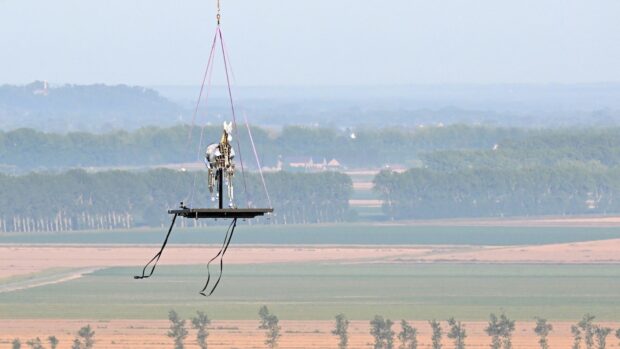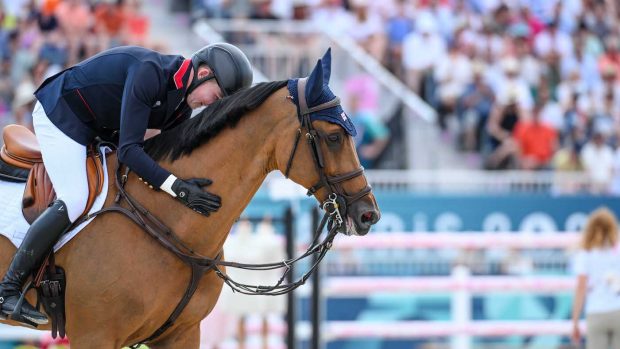Planning to watch Olympic equestrian cross-country for the first time from the Paris Games and have questions? We have the answers…
What is Olympic equestrian cross-country?
The cross-country is the second of three phases in the Olympic equestrian eventing competition. The first phase is dressage and the third showjumping.
Each horse and rider pair go round the cross-country course, in canter or gallop, jumping over solid obstacles. These include features such as water, ditches and steps up and down and also technical tests such as jumping narrow fences and fences at an angle. There will be a number of combination fences where the jumps are close together and there are not many strides between them. The striding may be set to be difficult so the horse needs to take particularly long or short strides to clear the obstacles successfully.
How long is the course?
The course in Paris is expected to be 5,300m long, so just over 5km.
How long will it take the horses and riders to complete the Olympic equestrian cross-country course?
The best horses and riders in Paris will finish under the optimum time, expected to be 9min 18sec, and by doing so, incur no penalties. Those who take longer than that will receive penalties for doing so.
There is no advantage to a rider being faster so long as they beat the 9min 18sec target – in fact, it’s best not to be too far under this time as that means unnecessarily tiring the horse out, which isn’t a good idea as they still have to complete the third phase of the competition, the showjumping, the next day.
How fast do the horses go?
Approximately 21 miles per hour for the horses which will finish without penalties. They will go faster at some points of the course than others, tending to speed up in between fences and slow down for the jumps.
How many horses and riders are on course at once? Do they race each other?
Each horse and rider tackle the course separately. It is not a race – they do not run and jump alongside each other.
The horses and riders in Paris will probably be set off at three-minute intervals, so in general there will be three or four pairs at different stages of the course at any one time. However, there could be less than three if a pair are eliminated or retired so leave the course before getting to the finish or more if a combination are particularly slow getting round.
Why doesn’t everyone jump the same jumps?
At some of the difficult fences, there are longer and shorter routes. There are no penalties for taking a long route (provided the horse and rider do not fall, refuse or run-out), but it will be time-consuming, so the rider will have to weigh up the risk of the shorter route against the time-penalties they may incur.
How many jumps are there on the Olympic equestrian cross-country course?
There are expected to be 25 numbered fences on the Paris track. But if there are several fences close together, they will be counted as one number, with the different elements denoted with letters of the alphabet, for example fence 23a or 14b.
How big are the fences?
The maximum size for completely solid fences at the Olympics is 1.20m high with a 1.80m top spread. Fences can go up to 1.40m if the top 20cm is brush, so the horses can push through the brush section rather than having to go cleanly over the top. Many of the jumps will be less than this permitted maximum because other factors make them challenging, such as the fact the fence is on an uphill or downhill slope, is narrow or is close to other jumps.
How does the scoring work for Olympic equestrian cross-country?
The whole eventing competition is scored in penalty points, so lower scores are better. Riders incur penalties for faults at obstacles such as refusals, run-outs or falls and also for exceeding the optimum time
- Find out more about eventing penalties
How many riders are in a team?
Each team has three riders, although most teams will also have an alternate, who can be swapped in between phases, although this will incur penalties.
- Read up on the Olympic eventing format
All the riders in teams are competing for individual medals as well as team honours. Some nations only have one or two riders, so they are only competing as individuals and are not part of a team.
How do the riders make the horses jump the fences?
Horses will have some training on the flat before they start jumping with a rider, so they understand the signals (the aids) the riders give with the legs, reins and body weight to indicate that they want to go faster, slower or turn.
When training for cross-country specifically, the riders start over small, easy fences and gradually build up to Olympic standard.
Some horses are naturally faster, braver and understand the challenge of cross-country better – riders will say the best horses “look for the flags” and want to go over the fences rather than avoid them. A horse is a big, strong animal and it is very difficult to make a horse do anything – the horses which excel in eventing and make it to Olympics are those who enjoy it and want to take part.
How often do the riders fall off?
Cross-country will always be an activity with an element of risk because it involves horses and riders jumping solid fences at speed. Everyone will fall at some point if they ride cross-country frequently and it is expected that there will be some falls on the Olympic course – probably five to 10 of the riders in Paris will fall out of a starting field of 65.
Is Olympic equestrian cross-country dangerous?
While many falls are innocuous, serious injuries to riders and horses do occur and occasionally even fatalities.
Those inside the sport constantly strive to make the sport safer with better training and appropriate qualification procedures for horses and riders, as well as technical innovations such as fences which are “frangible” and fall down if hit with a certain force.
You might also be interested in:

Everything you need to know about eventing at the Olympics

The Olympic eventing format – all your questions about penalties and substitutions answered

Horse & Hound’s essential guide to eventing penalties

Horses gallop across Versailles’ Grand Canal pontoon in ‘hugely exciting’ Paris Olympics test

Subscribe to Horse & Hound magazine today – and enjoy unlimited website access all year round
Horse & Hound magazine, out every Thursday, is packed with all the latest news and reports, as well as interviews, specials, nostalgia, vet and training advice. Find how you can enjoy the magazine delivered to your door every week, plus options to upgrade your subscription to access our online service that brings you breaking news and reports as well as other benefits.




